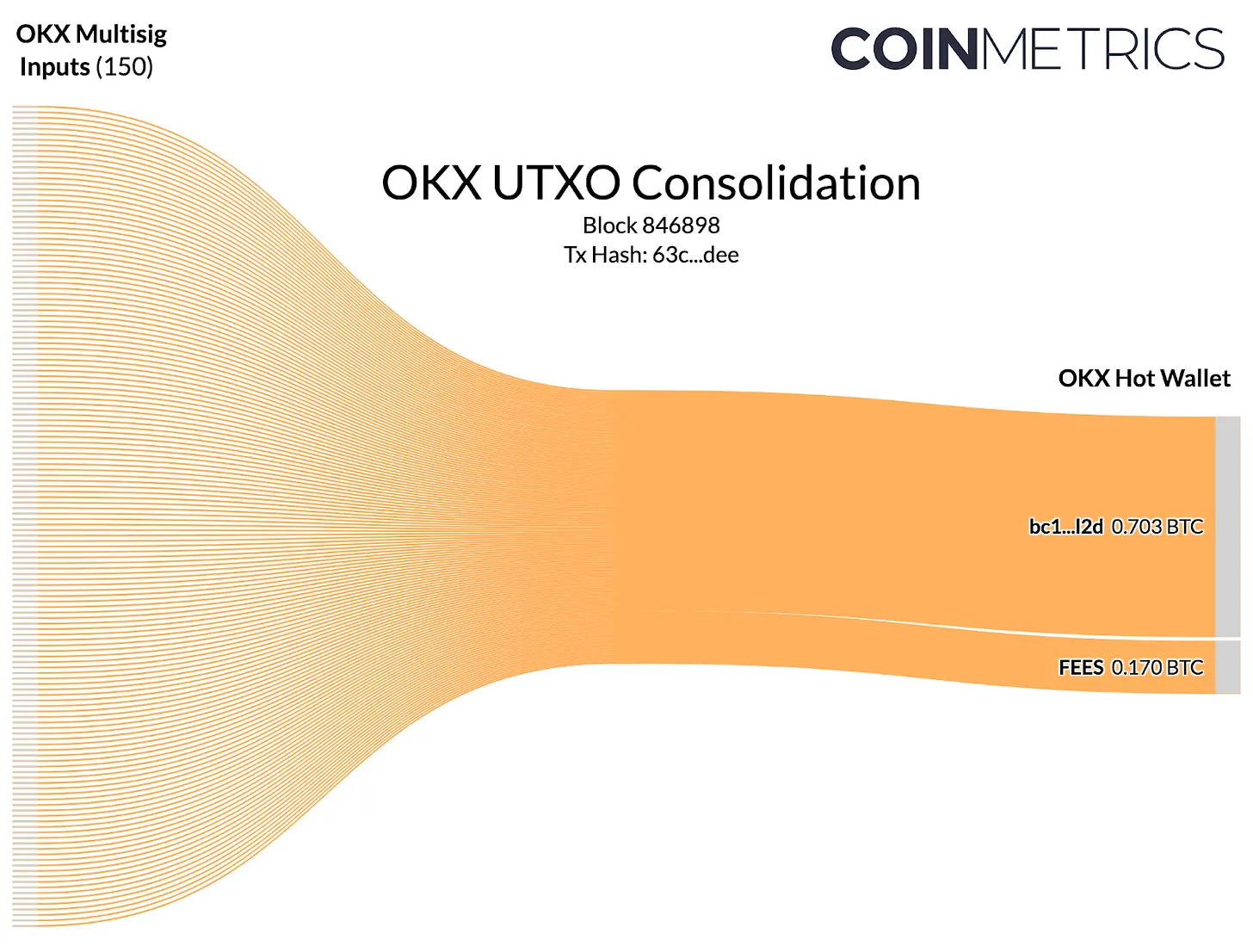Original title: State of the Networks Q2 2024 Mining Data Special
Original author: Parker Merritt
Original source: substack
Original translation: Eason, Mars Finance
Key Takeaways:
After the halving, Bitcoin’s hash rate (30-day moving average) has fallen 7% from its all-time high of 626 EH/s to 580 EH/s currently.
OKX’s massive UTXO consolidation brought a brief boost to transaction fee revenue, with miners earning $38 million in transaction fees in 3 days
Toronto-based mining company Bitfarms has made impressive progress in mining efficiency, reducing incremental energy consumption from 35 J/TH to 27 J/TH by 2024.
At the peak of the 2021 bull run, the Antminer S 19 traded at as high as $100/TH, but is now trading as low as $2.5/TH on the secondary market.
introduce
This week’s State of the Network report reviews the Bitcoin mining landscape, continuing our series of quarterly updates on the state of proof-of-work stakeholders. Since the Bitcoin halving in April, mining margins have been under pressure due to stagnant BTC prices and a depressed fee market, although short periods of on-chain congestion have brought some revenue relief. Many operators are diversifying away from pure mining, reinventing themselves as general-purpose infrastructure providers in an attempt to secure hosting contracts for power-hungry AI applications. At the same time, improvements in chip efficiency continue unabated, forcing miners to consider whether to continue using aging ASIC hardware or undertake a comprehensive fleet upgrade. In this report, we’ll delve deeper into each of these factors, investigating the health of the mining industry beyond BTC price performance.
Integrated operations
At first glance, Q2 2024 looks like a relatively profitable period for Bitcoin miners. This quarter ranks fifth in terms of total USD revenue out of the 18 quarters since January 2020, with miners bringing in $3.77 billion between block subsidies and transaction fees. Of course, these gains are front-loaded thanks to the halving, with nearly half of this quarter’s revenue coming in April alone. May and June have been even tougher months for miners after the Bitcoin block reward dropped from 6.25 BTC to 3.125 BTC on April 20 and “Rune” token hype faded in the weeks that followed. As a result, Bitcoin’s hash rate is showing signs of miner capitulation — at 580 EH/s, the hash rate’s 30-day moving average is down -7% from its all-time high of 626 EH/s.

Source: Coin Metrics Network Data Pro
Despite the weakening of overall revenue momentum, the unexpected increase in on-chain traffic has provided some respite for miners. In early June, the Bitcoin memory pool was hit by an influx of high-fee transactions, with average hourly transaction fees as high as $945 as of noon on June 7. The congestion greatly increased mining revenue, with the hash price (daily USD revenue per TH/s) soaring to $0.09, and fees accounting for more than 42% of revenue.
Source: Coin Metrics Network Data Pro
While fee spikes are often attributed to token protocols like Ordinals Runes, the latest mining revenue growth was driven by the internal operations of a single centralized exchange. OKX (the fourth-largest exchange by BTC spot trading volume) conducted a series of large-scale UTXO merges to clean up its books by combining fragmented Bitcoin portions into larger, more compact denominations. Since BTC transactions are priced based on the block space they consume, transactions involving many UTXOs are more expensive to transfer, and merged UTXOs unlock payments in a lighter, more cost-effective on-chain space.

Source: Coin Metrics ATLAS
The UTXO consolidation process is similar to pouring a jar of change into a coin counting kiosk in exchange for a $20 bill. However, as with Coinstar, this service comes at a price. While daily fee revenue is typically around $1-2 million, miners made nearly $38 million in the 3 days after OKX performed UTXO consolidation. In retrospect, OKX could have performed accounting cleanup in a more efficient manner, paying a hefty premium for fast settlements — but miners certainly aren’t complaining in the face of quiet transaction queues and record-low hash prices.
About infrastructure
In the weeks since Bitcoin’s halving, most publicly traded mining companies have traded sideways alongside BTC. Shares of the three largest mining companies, Marathon Digital (MARA), CleanSpark (CLSK), and Riot Platforms (RIOT), have struggled to outperform BTC in the second quarter, with only Marathon eking out a relatively small return. So far, the biggest winners have all been the underdogs in the Bitcoin mining race, with Core Scientific (CORZ), Iris Energy (IREN), and TeraWulf (WULF) all outperforming their competitors by double digits. It’s no coincidence that these companies have piled into the AI hype wave in droves, positioning themselves as energy and infrastructure providers for a wider range of computing applications.
In June, Core Scientific signed a series of multi-billion dollar contracts with “AI hyperscaler” CoreWeave, agreeing to use hundreds of megawatts of power capacity to host the company’s high-performance computing (HPC) hardware. Shortly thereafter, Core Scientific received an “unsolicited proposal” from CoreWeave to acquire its entire business, but rejected it, citing Core’s “growth prospects” and “value creation potential.” IREN and WULF also highlighted the unique positioning of their managed HPC infrastructure as making them attractive partners (and possible acquisition targets) for increasingly energy-constrained AI-focused conglomerates.

Source: Coin Metrics Reference Rate and Yahoo Finance
For other miners, price action has been driven primarily by mergers and acquisitions within the industry. While micro-miner GRIID Infrastructure (GRDI) has lagged behind its peers since going public this year, CleanSpark announced its acquisition of the company in June, claiming that the deal would increase its power capacity by 400 megawatts in 2 years. In May, Riot Platforms disclosed its 9.25% stake in Bitfarms (BITF), a slightly smaller miner that is currently experiencing corporate governance issues. Riot offered approximately $950 million to acquire Bitfarms wholesale, claiming that the acquisition would create the worlds largest publicly traded Bitcoin miner by the end of the year. Bitfarms immediately rejected the offer and blocked Riots hostile takeover by issuing a poison pill plan, which is designed to dilute entities seeking acquisitions on the open market.
Riot’s motivation for acquiring Bitfarms can be attributed to a variety of factors, but one notable aspect is its massive improvement in efficiency. Historically, Bitfarms has taken advantage of low-cost hydroelectric power and used older generation ASICs rather than upgrading to state-of-the-art hardware. This caused them to lag behind competitors in metrics such as fleet efficiency – measured in “joules per terahertz” (J/TH) – which represents the incremental energy consumed to produce hashrate. However, Bitfarms recently implemented a comprehensive fleet refresh, purchasing 16 EH/s worth of Antminer T 21s (19 J/TH). In 2024, Bitfarms’ average fleet efficiency increased from 35 J/TH to 27 J/TH, surpassing Riot’s stagnant efficiency of 27.7 J/TH.

Source: Coin Metrics MINE-MATCH and public disclosures
Bitfarms isn’t the only company making significant progress in average mining machine efficiency. Over the past 6 months, Iris Energy has reduced average energy consumption by 15% to 25 J/TH, while TeraWulf has increased efficiency by 11% to 24.6 J/TH. Core Scientific, which has emerged from Chapter 11 bankruptcy proceedings, currently leads the pack with an efficiency of 24.23 J/TH, beating out current efficiency leader Marathon Digital, which is at 24.5 J/TH. As the race to streamline and optimize operations shrinks to decimal points, miners are now looking to the next generation of ASICs for the next opportunity to leapfrog their competition.
The ASIC Era
After more than a decade of chip manufacturing innovation, Bitcoin mining ASICs have achieved unprecedented efficiency improvements. The first commercial ASIC, Canaan Creative’s Avalon 1, was released in January 2013 with a hash rate of just 0.06 TH/s. The power consumption was 620 watts, which equated to an efficiency of 10,333 J/TH. At the time, this was a huge leap in raw hash rate output, with the entire network hashing at just 22 TH/s. Soon after the release of the Avalon 1, competing manufacturers entered the market, and continued technological advancements increased the hash rate by 14,000 times in 2 years.
Since then, efficiency gains have tapered off from their early exponential growth, but manufacturers are still aggressively slashing the energy required to produce incremental units of hashrate. In June, Bitmain released its latest series of Antminer S 21 XP models, with a water-cooled version hitting 473 TH/s with an efficiency of 12 J/TH. While Bitmain remains a giant in the industry, upstarts like BitDeer — led by former Bitmain CEO Jihan Wu — have announced ambitious plans to produce 5 J/TH ASICs by the second quarter of 2025.

Source: Coin Metrics Network Data Pro and Bitcoin Mining Museum
As Bitcoin miners begin to liquidate existing hardware in favor of more efficient models, ASIC prices are falling. While nominal prices vary depending on hardware specifications, ASIC trading desks typically quote prices in dollars per terahertz ($/TH), providing an easily comparable metric for measuring the premiums of various models.
The 2021 bull run (coupled with China’s mining ban) contributed to a period of super-profitability in BTC mining. This led to high premiums for Antminer S 19 models (90-110 TH/s), with prices remaining high around $90-100/TH throughout the year. However, in 2022, plummeting revenues put significant pressure on ASIC premiums, with S 19 prices falling by more than 80%. Post-halving, secondary markets such as Kaboomracks continue to capitulate, with the poorly performing S 19 models trading as low as $2.5/TH in June.

Source: Coin Metrics Network Data Pro and Kaboomracks
Despite losing the shine of the new generation, ASIC fingerprinting technology shows that the S 19 series still contributes more than 50% of the hash rate, indicating that they are being redeployed to lower-cost sites rather than being retired entirely. Even the 2016 Antminer S 9 has maintained a place at the edge of the grid, still reliably turning waste energy into electronic cash nearly a decade after its debut. While the most efficient operators will undoubtedly choose to replace their miners with the latest models, the rugged and highly industrialized form factor of modern Bitcoin mining ASICs ensures that almost every machine will eventually find a place in the proof-of-work ecosystem.
in conclusion
Bitcoin’s fifth era is likely to be characterized by consolidation, with deep-pocketed miners acquiring the assets of less efficient operators. The AI industry also envies the industry’s unique energy infrastructure, and many publicly traded miners have successfully adopted more general data center strategies. Others remain focused on Bitcoin, viewing HPC juggling as a temporary distraction. Regardless, to survive the onslaught of efficiency gains and competitive pressures, all miners must look to the future, and the long-term trajectory of BTC prices remains an unpredictable input to a highly capital-intensive business model.










